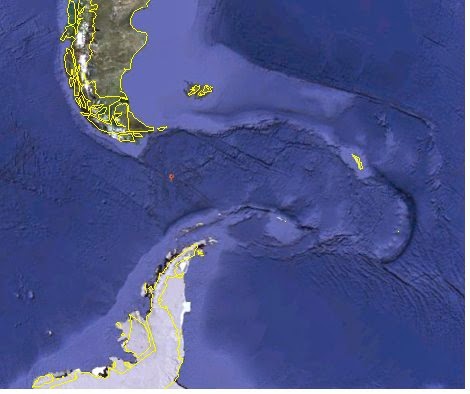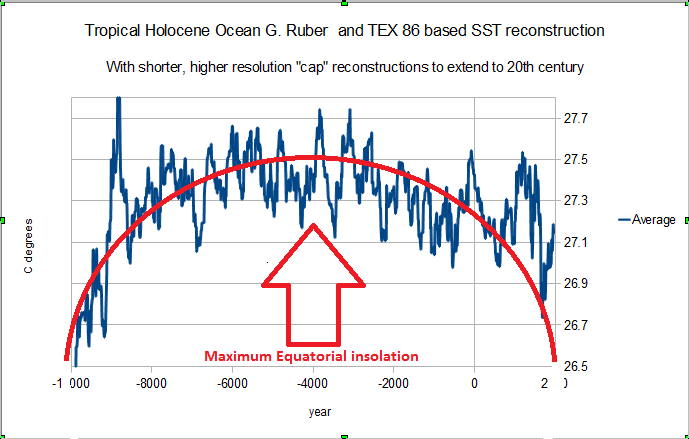Part of the Hemispheric See Saw and the shift from 41ka to 100ka glacial cycle shift is a tough nut to crack. Herbert et al. produced a tropical ocean reconstruction with some part going back over 3 million years. The Atlantic core they used had some issues so there is a major gap, but the Arabian Sea, South China Sea and Eastern Pacific looked pretty good. Liu and Hebert also published this 1.8 million year reconstruction of the Eastern Pacific, which I have interpolated and binned to 1kyr for some other stuff I am doing. Open Office doesn't have a nifty interpolation routine for sporadic paleo core time series so I cludged this together. Not great, not bad.
"
Many records of tropical sea surface temperature and marine
productivity exhibit cycles of 23 kyr (orbital precession) and
100 kyr during the past 0.5Myr, whereas high-latitude
sea surface temperature records display much more pronounced
obliquity cycles at a period of about 41 kyr. Little is
known, however, about tropical climate variability before the
mid-Pleistocene transition about 900 kyr ago, which marks the
change from a climate dominated by 41-kyr cycles (when ice-age
cycles and high-latitude sea surface temperature variations were
dictated by changes in the Earth’s obliquity) to the more recent
100-kyr cycles of ice ages. Here we analyse alkenones from marine
sediments in the eastern equatorial Pacific Ocean to reconstruct
sea surface temperatures and marine productivity over the past
1.8Myr. We find that both records are dominated by the 41-kyr
obliquity cycles between 1.8 and 1.2Myr ago, with a relatively
small contribution from orbital precession, and that early Pleistocene
sea surface temperatures varied in the opposite sense to
local annual insolation in the eastern equatorial Pacific Ocean.
We conclude that during the early Pleistocene epoch, climate
variability at our study site must have been determined by
high-latitude processes that were driven by orbital obliquity
forcing."
This is their abstract that accompanies the data at NCDC paleo.
When I compare the tropical reconstruction with the solar insolation, the best correlation I get is with the Equatorial peak as I have mentioned in previous posts. Of all the tropical reconstruction I have seen, the Eastern Pacific has the largest cooling trend for the past million years actually starting around 2.7 million years ago. I believe that is due to flow increasing through the Drake Passage and prior to that, Antarctic ice could clog the passage during SH glaciation/de-glaciation some what, but erosion possibly reduced the chances of a major blockage over time.

This Google Earth image shows the scouring pattern and the volcanic island ring at the outlet. Ice blockage would reduce flow and it could divert flow making it very difficult to figure out what is happening. That is one of the reasons I abandoned the Southern Oceans because there is just to0 much going on for it to be a fun problem.
Back when I was looking at the Southern Oceans I noted the similar scouring at the former Panama gap. They are similar enough that I would believe that massive ice sheets were responsible for both. Whether or not that is the case, both were likely major regulators of ocean circulation. When ocean water can flow more efficiently to the polar heat sinks that would tend to reduce average ocean heat capacity and SST. When the SH glaciation was able to expand northward more, the tropics would show a stronger obliquity cycle signal, ~41ka and without that they can synchronize with weaker signals in multiples of ~10ka +/-2ka or the rectified equatorial precessional cycle. You end up with roughly the eccentricity cycle related glacials, but since eccentricity is pretty weak, the frequency can shift back to 41ka or even ~21ka, the regular old precessional cycle beat.
Since the precessional cycle is influenced by glacial mass throwing things out of balance, a uniform SH glacial mass would tend to reduce wobble which could alter the precessional frequency. That is pretty much the case since "Wobble" has just about stopped. What that means in the future I have no clue. I just suspect that you can't count on any regular ice age pattern to be predictable. The Holocene could last another 20 thousands years if something doesn't change things.
The point of this post though is the temperatures recorded by Lui and Herbert seem to be about 2 degrees lower than they should be. Lea et al. 2007 is a reconstruction off the Galapagos which is very close to the same location and has a temperature closer to what I would expect.
It indicates close to 25 C during the Holocene peak.
The Reynolds satellite data for that area is around 28C. SST as I have mentioned before is a bit confusing since what the actual skin temperature is isn't what is being measured by buckets, intakes or plankton. Since the convective triggering is around 28 C, cold oceans in the tropics would not produce the energy needed to build ice sheets, so something appears to be amiss. A bit of a stumbling block as far as what I a doing in any case.
This is the issue, z, meters per bug type. The G. Ruber white and pink are your normal "surface" temperature proxy. They over lap with a range according to Farmer et al. 2007 from 0 to about 39 meters. 39 meters is a huge range for "surface" temperature depth readings. This is wet suit instead of shorty range depending on the time of year. The N. Tumida bug likes a 175 to 275 depth range so it is used for "sub" surface temperatures. Most every living organism has a temperature preference so the same bug in the higher latitudes would tend to be shallower than in the tropics. You also have variations in ocean currents that would move bugs from one location to another. So if current direction changes, and most often it will, you would have bugs from a different temperature zone from time to time settling to the bottom when they croak.
This is one reason I prefer the Indo-Pacific Warm Pool and other locations that would tend to have less current variability. None of this is new to the paleo world, but the confidence intervals are based on how well they measure what is deposited and not always on issues that impact the depositing. So when Herbert et al. note they have +/-0.2 C temperature accuracy, they are talking about their lab quality not their core quality.
All this means is that when I put together a tropical ocean reconstruction using various cores I am not going to provide confidence intervals that don't mean diddly. I am just going to provide the mean or average with the binned and interpolated data with what some might consider a "handwave" at confidence. It is better to be honest than over confident doncha know?
This is more a PostIt note than a real serious post, but for the loyal followers of my blog, all both of them :), I thought I would throw it up.
By the Way, Proper citation for anything you lift from this blog is, "Some Redneck Posted ..." or you can get into more detail if ya like.
Update: a good example
ACK! These are Eastern tropical SST reconstruction all close to the equator. There is seven degree C difference between the coldest and warmest. The longer term recons are by Lea et al. and the shorter ones by Stott et al. Now if I use these, I am going to have to re-calibrate if I hope to get a reasonable approximation of actual SST.
And here we have 5 million years of sub-surface temperatures for the same region. That is a huge swing for this region even over 5 million years. So there is going to be a lot of double checking and weeding out of recons that will just end up causing "cherry picking" accusations.

































